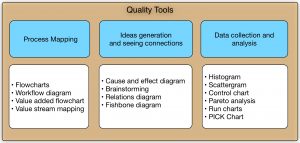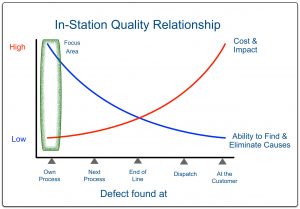Work in a lean system needs to be highly defined in terms of required inputs, the sequence of operations and the expected outcomes. One of the key manufacturing elements that spans across these three areas is Quality. In production, quality has been a well-established principle and some companies have the size and complexity to maintain whole departments to support a quality system. Is it possible to define a quality system without having such support? We believe it is, when we consider the fundamental points of starting with your customer and their quality requirements, understanding what a quality approach means to your business, mapping your processes, utilising the available tools and committing to fixing your quality as soon as an error is found.
Start with Your Customer
From a customer standpoint, the only acceptable level of quality is zero defects. This is understandable even when you, as a customer buy an item; there is often a moment just before we take an item home, your internal voice says “Oh, I’d better check it”. We check for the right quantity, size and any defects such as if the eggs are cracked, missing stitches on a garment or brown spots on fruit.
In manufacturing our customers define their quality requirements in a number ways. We may be provided with drawing with manufacturing tolerances, a specification with an acceptable number of defects or provide with a range of acceptable limits for key feature of our product. Each industry has a different approach to defining what quality means to both the customer and the supplier. Fully understanding your requirements is the first step in ensuring we are improving our work with a quality mindset.
Understanding a Quality Approach
For a long time, Quality has been the cornerstone of manufacturing and servicing organisations to address the concerns we have as customers. Rightfully, quality improvement has a long history in organisational thinking and practice. Quality systems have evolved through many stages of inspection, quality control, quality assurance, quality management and quality improvement. Along the way a wide variety of language has been developed to described quality such as Total Quality Management, Quality Improvement, Continuous quality improvement and even Business Excellence.
There many excellent sources of information and many key people like Schein, Liker and Demming that are worth looking up (see references below.)
Mapping Your Process with a Quality Focus
While there are differences between the approaches towards quality from the people mentioned before, and across a range of industries, there is also much in common with how we can define the required quality outcomes from our processes.
To do this, we need to fully understand our manufacturing processes and check that we have our required quality at front of mind at all times. The process to do this is as follows:
1. Process mapping using tools such as a Value Stream Mapping approach
2. Gathering and analysing data. Here we may use tools such as flowcharts, Pareto analysis, fishbone diagrams and benchmarking.
3. Then gather feedback from the data and use it to analyse and identify opportunities to improve the process
Note that the same approach also applies to office and service industry processes. Spending time to develop a common understanding of your processes and quality points is key to improving your processes.
Using the Quality Tools to your Advantage
Each step in defining your manufacturing process has a set of tools that can aid you on your quality journey. Defining what quality means in a product or service is a function that can be defined and understood in what you offer to your customers. Then taking this requirement and drilling deeper into the process you can identify where this feature is created in your business. You can determine if there a standard to control this feature, at this point in the process. If you are not carefully controlling how your key features are added to your product, you are leaving yourself open to creating errors into your product.
To clearly define your process, you can use any of the tools from a simple flowchart, to a fully detailed value stream map. Brainstorming and Fishbone diagrams can help your team to generate ideas and see the connections between process steps where product features are being added and the associated quality points that make up the customer requirements.
And finally there is a range of data analysis tools that help you to collect information about your processes and look at it in different ways, helping to visualise relationships between different elements.
Fixing Quality Early in your Process
We can see from the chart the relationship quality can have on two fronts; the ability to find the cause and the impact of the error, across progressive stages of the process.
To further highlight the importance of focusing on the right quality at the right time, we know from experience that when errors are found in our own process, they have the lowest cost and impact to the business, and the root causes can be found more easily and eliminated. As production continues and the product with the error moves closer to identify and eliminate the possible causes of the error are harder to achieve. This is why finding errors at the earliest point in your process are vital to implementing a quality improvement in your business.
In Summary
Quality is the key element we need to embed into our processes to ensure we approach our improvements with a quality mindset. It is possible to have a company with a defined quality system without needing to support an entire quality department. As we implement our improvement program, we need to consider our customer’s quality requirements, understand how a quality approach impacts our business, map our processes, use the appropriate tools to help us see what is really happening and committing to fixing our quality as soon as an error is found.
Then we know we will be improving our work with a quality mindset that is sustainable.
References for further reading
1. Organizational Culture and Leadership by Edgar H. Schein
2. The Essential Deming, edited by Joyce Nilsson Orsini PhD
3. Root Cause Analysis: The Core of Problem Solving and Corrective Action, Duke Okes.
4. The Toyota Way, Jeffrey K. Liker, 9780071392310
5. Lean Six Sigma for Service: How to Use Lean Speed and Six Sigma Quality to Improve Services and Transactions 1st Edition by Michael George.
6. The Quality Toolbox 2nd Edition Nancy R. Tague, American Society for Quality, Quality Press 2005







